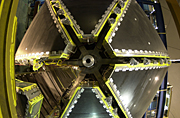- Number 327 |
- December 20, 2010
Mixed matter/anti-matter beam provides unique peek into protons

Closeup of the CLAS detector
used in the experiment
Seeking a clearer picture of electric charge inside the proton, DOE's Jefferson Lab is producing the world's most intense beam of mixed matter and anti-matter.
The proton is the primary source of the nucleus' positive electric charge. It is the positive charge that locks negatively charged electrons into orbit around the nucleus, thus forging the atom itself.
But according to Larry Weinstein, a professor at Old Dominion University who conducts experiments at Jefferson Lab, scientists still don't fully understand how that charge is distributed within the proton.
"Right now, there are two different measurements of how electric charge is distributed in the proton that disagree by a factor of three in places," Weinstein said. "As you might imagine, this difference is causing serious difficulties in our understanding of the proton."
To gain better insight, a team of more than 100 scientists, led by six co-spokespeople including Weinstein, banded together to do a first-ever mixed matter/anti-matter beam measurement of the proton.
To produce the beam, they take high-energy electrons from Jefferson Lab's Continuous Electron Beam Accelerator Facility accelerator and direct them through a thin tungsten sheet. The sheet causes a few percent of the electrons to emit high-energy photons. These photons then pass through another thin tungsten sheet, where another few percent convert into a pair of particles: the electron and its anti-matter twin, the positron.
"That will produce about 0.3 billion electrons and the same number of positrons per second," Weinstein said. "The beam is the most intense high-energy, mixed matter/anti-matter beam in the world."
Ordinarily, matter and anti-matter twins would sooner crash into each other in a blaze of self-annihilation than travel along together in a mixed beam. To keep the particles intact, the electrons and positrons are spread over a distance of about two inches.
A series of magnets focuses the matter/anti-matter beam into a target filled with liquid hydrogen. Hydrogen's nucleus consists of a single proton, so any electrons or positrons that interact with the hydrogen nuclei in the target will provide information on the proton.
A detector that encompasses the target, known as the CLAS detector, is used to measure and identify the electrons and positrons that interact with protons in the target, as well as any protons that are knocked out of the target by the beam.
"By measuring both [interactions] simultaneously, we can measure the difference between them very precisely," Weinstein explains.
Other experiments have measured the charge distribution of the proton using two methods that should give the same answer but, as Weinstein pointed out, disagree by a factor of three in places. While there is an explanation for the discrepancy that some scientists think is valid, this precise measurement is needed to verify it.
The experiment began in early December and is scheduled to run through late February.
Submitted by DOE's Jefferson Lab
